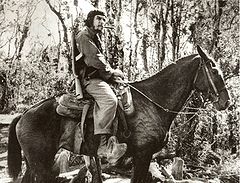Che-The Argentine
 Directed by Steven Soderbergh, Che: Part One – The Argentine is a biographical portrait of the Latin American revolutionary Che Guevara. The Argentine portrays the years of 1956 to 1958, when Che Guevara meets Fidel Castro and then joins him in a guerrilla campaign that would eventually overthrow Batista’s dictatorship.
Directed by Steven Soderbergh, Che: Part One – The Argentine is a biographical portrait of the Latin American revolutionary Che Guevara. The Argentine portrays the years of 1956 to 1958, when Che Guevara meets Fidel Castro and then joins him in a guerrilla campaign that would eventually overthrow Batista’s dictatorship.
Since the 1920’s Mexico has been known as a safe haven for political exiles, however by the time Guevara arrived, Mexico had become known as an important channel for U.S. capital and an ally during the Cold War. In letters to his family Guevara would write that “Mexico is entirely given over to the Yankees…There is no independent industry, much less any free trade. Guevara frequently speaks of American imperialism which he describes as the last stage of capitalism. Guevara would also describe his life in Mexico, his lack of work, his relationship status, and his attempts to practice medicine. He was bored, and he didn’t feel that Mexico was for him, he wrote to his mother and told her that his objective was Europe, and this is where he intended to go no matter what. At this time there is no indication that Guevara would use Mexico as a training ground for his future revolutionary experience.
In July 1955 Guevara would meet Fidel Castro in Mexico City and this would change everything. In his letters home he would describe his exciting and eye opening encounters with Castro, as well as affirming his own self identity as one with a sense of purpose. Ernesto is no longer, he now signs his letters “el Che.” Che would now devote himself to the Cuban cause. During one of his meetings Che would be introduced to Nikolai Leonov, who would encourage Che to study Russian, Russian literature, Marxism and economics. Castro would also train Che with a physical program that would include marches, hikes, wrestling, karate, and marksmanship to prepare him for what was to come.
During a series of raids by Mexico’s secret police, Che would be captured and in a U.S. Embassy report Che would be identified as “a well known Argentine Communist who had been active in Guatemala.” With the intervention of Lazaro Cardenas, Castro and Che would be released from jail and would  leave from Veracruz to begin their revolution. For Mexico, Che would represent a revolutionary that was passionate and willing to die for his views, a bohemian that the youth of Mexico would admire as a hero.
leave from Veracruz to begin their revolution. For Mexico, Che would represent a revolutionary that was passionate and willing to die for his views, a bohemian that the youth of Mexico would admire as a hero.
Cuba would be a setting very different from what Che had experienced in the past. Che’s training and discipline would be tested over and over not only with his health issues but also with the terrain and the men he must employ to help with the cause. Che believed “guerilla warfare is a people’s warfare; an attempt to carry out this type of war without the population’s support is a prelude to inevitable disaster,” and “the guerrilla is supported by the peasant and worker masses of the region and of the whole territory in which it acts.” The film illustrates Castro’s and Che’s determination to convince locals to trust them and join the resistance. Guerilla warfare as a character in the film, played the part of showing how the people were able to win a war against its oppressor. 
After Cuba, Che would go on to Bolivia, which would become the setting of his final chapter. Che would be assassinated and Thomas Hughes would write that Che’s death was a fatal blow to the Bolivian guerilla movement.
It would be Che’s passion that fueled the revolutions, and gave hope to the oppressed.
